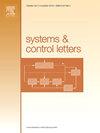Adaptive boundary observer for Euler–Bernoulli beam equations with nonlinear dynamics and parameter uncertainties
IF 2.1
3区 计算机科学
Q3 AUTOMATION & CONTROL SYSTEMS
引用次数: 0
Abstract
This paper focuses on designing boundary adaptive observers for systems that can be modeled as Euler–Bernoulli beams and are represented by fourth-order partial differential equations. Specifically, the objective is to estimate the entire state of the beam solely based on measurements taken at its boundaries. The difficulty of this study lies not only in the uncertain parameters contained in the boundary and domain of the beam but also in taking into account the interior nonlinearity in-domain. Unlike many observers in adaptive control frameworks that do not require accurate estimation of unknown parameters, our approach is dedicated to accurately estimating both the system state and the unknown parameters. The crucial element in the design process of the adaptive observer is the introduction of a kind of finite-dimensional backstepping-like transformation, based on which we can transform the observer error system into the desired system. Then, we can use common parameter estimation methods, allowing the design of the parameter adaptive law to be decoupled from the choice of the state estimator. Using Lyapunov stability analysis, we show that the observer converges exponentially under persistent excitation conditions. Numerical simulations also demonstrate the effectiveness of the observer.
具有非线性动力学和参数不确定性的欧拉-伯努利梁方程的自适应边界观测器
本文主要研究用四阶偏微分方程表示的欧拉-伯努利梁系统的边界自适应观测器的设计。具体来说,目标是仅根据在其边界处进行的测量来估计光束的整个状态。本研究的难点不仅在于梁的边界和区域中包含的不确定参数,而且还在于考虑了区域内的内部非线性。与许多不需要准确估计未知参数的自适应控制框架中的观测器不同,我们的方法致力于准确估计系统状态和未知参数。在自适应观测器的设计过程中,最关键的是引入一种有限维的类步进变换,在此基础上将观测器误差系统转化为期望系统。然后,我们可以使用常用的参数估计方法,使参数自适应律的设计与状态估计器的选择解耦。利用李雅普诺夫稳定性分析,证明了在持续激励条件下观测器是指数收敛的。数值模拟也验证了该观测器的有效性。
本文章由计算机程序翻译,如有差异,请以英文原文为准。
求助全文
约1分钟内获得全文
求助全文
来源期刊

Systems & Control Letters
工程技术-运筹学与管理科学
CiteScore
4.60
自引率
3.80%
发文量
144
审稿时长
6 months
期刊介绍:
Founded in 1981 by two of the pre-eminent control theorists, Roger Brockett and Jan Willems, Systems & Control Letters is one of the leading journals in the field of control theory. The aim of the journal is to allow dissemination of relatively concise but highly original contributions whose high initial quality enables a relatively rapid review process. All aspects of the fields of systems and control are covered, especially mathematically-oriented and theoretical papers that have a clear relevance to engineering, physical and biological sciences, and even economics. Application-oriented papers with sophisticated and rigorous mathematical elements are also welcome.
 求助内容:
求助内容: 应助结果提醒方式:
应助结果提醒方式:


